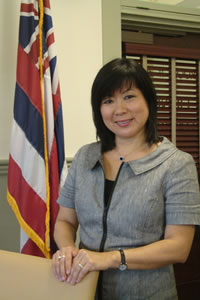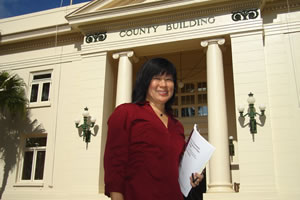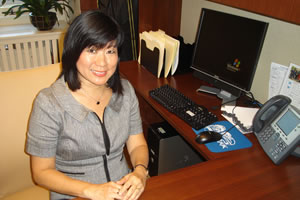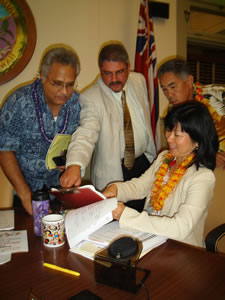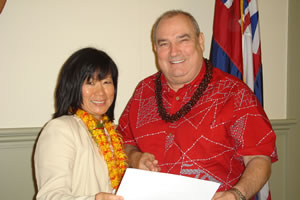Planning a Better Future for Kaua’i
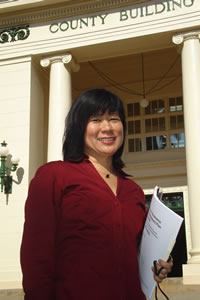
With a background in urban and regional planning, first-term councilwoman Nadine Nakamura wants to preserve what's best about Kaua'i while also planning sensibly for inevitable growth
First-time Kaua’i County Councilwoman Nadine Nakamura wants to improve the quality of life for everyone on Kaua’i.
“That, for me, is the bottom line and why I’m doing this,” she says. “How can we improve our life on this island for us and for future generations?'”
It seems she’s already helped answer that question.
Nakamura, who was elected in 2010, was responsible for placing funding in the last budget for a full-time transportation planner the county is now in the process of hiring.
“We’re looking at not just planning for cars, but for people and bicycles. We need somebody thinking and just focusing on that,” says the Kapa’a resident who once worked with Honolulu Rapid Transit Project. “It’s amazing that transit use has increased exponentially over the past few years. It shows the strong demand for the bus system.”
Money also was allocated in the budget by Nakamura aimed at diversifying the local economy. Funds were collected for food and agricultural matters, such as conducting a study on whether it would be feasible to have a slaughterhouse on-island.
Not only is she proud of helping establish a more diversified economy, Nakamura also is satisfied with a transient accommodation unit bill she helped pass last year.
“That was a huge project, a very complex piece of legislation,” she says.
The bill balances the rights of developers with citizens concerned about resort growth.
“We got everybody around the table, and the council unanimously approved the bill I helped to amend,” she says. “It was a huge accomplishment.”
Everyone adores the island because of its natural beauty and rural character, she notes, so it is imperative to find a balance between future growth and preserving Kaua’i’s beauty and open space.
“Nadine’s focus on controlled growth, on preserving the environment and on building a future for Kaua’i that our keiki can thrive in, are aspects of her platform that I think most voters can nod their heads at,” says Jack Yatsko, a psychiatric rehabilitator for the International Center for Clubhouse Development. “My wife and I have lived on Kaua’i 24 years, our kids were born and raised on Kaua’i, and we want someone who will help Kaua’i stay Kaua’i while honoring a variety of cultures and value systems with integrity, passion and conviction. Nadine Nakamura is that person.”
While Nakamura is quite familiar with protecting nature, especially as she advised the Open Space Commission and helped get the entity off the ground, her current position is her first direct experience in the political arena.
“People encouraged me to run for office,” she says.
The learning curve is very steep and her greatest challenge has been getting up to speed.
“A lot of it is new to me,” she says. “But I’m really enjoying it.”
The first time Nakamura enjoyed learning about politics was in college at the University of Southern California, and spent a semester away in Washington, D.C. She was then Nadine Maeda, a graduate of Oahu’s Radford High School.
“We really got a good overview of the government at the federal level,” says Nakamura. “At the time, Reagan was president and he was dismantling a lot of federal bureaucracy.”
She attended classes, took field trips to the Pentagon and executive offices, and interned at a neighborhood investment corporation a nonprofit that had bipartisan support to help revitalize neighborhoods around the country.
“That was really in line with my degree in urban and regional planning,” she explains. “The professionals whom I worked with there showed me that women can really work at high levels and do good things and make a difference in their communities.”
Following her internship, Nakamura had planned to achieve a master’s degree at Massachusetts Institute of Technology.
“But after one semester on the East Coast, I decided I wanted to come back home,” she says.
Steering away from politics for awhile, she moved back to Honolulu and earned a master’s in urban and regional planning at the University of Hawai’i-Manoa. While she was in school on Oahu, Nakamura interned at the Hawai’i Community Development Authority, an organization created to redevelop the Kaka’ako area between downtown and Ala Moana.
Her favorite job on O’ahu after graduating, however, was working for the Pacific Housing Assistance Corporation a statewide nonprofit that develops affordable housing.
“It made me understand development and the difficulty of developing affordable housing because it requires so many different sources of funding to make a project work,” she says. “It was probably the most satisfying job because you know you’re building affordable housing that will be in perpetuity.”
It’s something Nakamura would like to see more of on Kaua’i.
“We really need to look at the range of possibilities and help facilitate making this happen,” she says.
Though she took pleasure in her job on O’ahu, what finally brought Nakamura to Kaua’i was love. She met her husband, attorney Galen, while attending UH.
“Our paths crossed,” she says.
While he left shortly thereafter to attend law school in San Francisco, they married when he returned to O’ahu.
Galen moved to Kaua’i to be closer to his family, and after about a year, Nakamura quit her beloved job to join her husband on the Garden Isle in 1992 right after Hurricane ‘Iniki ravaged the island. Though it took an extra effort to launch her new business during such a devastating time for the island, her consulting enterprise, NKN Project Planning, has since excelled.Nakamura has worked on a range of projects, including launching the Kaua’i Planning and Action Alliance.
“There was no one neutral entity to bring together all these different players to address some problems that are common to all,” she says about why KPAA, which was established a few years ago, was needed.
At the same time she was developing KPAA, Nakamura helped create a statewide nonprofit call Hawai’i Home Ownership Center a one-stop shop for first-time homebuyers. Most recently she helped develop strategic plans for Kaua’i United Way and National Tropical Botanical Garden. In fact, the NTBG plan won an environmental award last year from American Planning Association for its holistic approach to land management.
“A lot of times you have one area, but you don’t take into account all the connections,” she says about the plan that involved all components connected to Allerton Garden, including land, sand and sea.
“We’ll make sure that this area is preserved forever,” she says.
Nakamura has had other innovative ideas come to fruition, such as an afterschool program for Kapa’a Elementary School.
“I did a survey and noticed that most of the kids had nothing to do after school,”
she says. So she helped create classes for keiki, including digital storytelling and hula. “I wanted to help kids build their confidence, kind of open their world to something different.”
She also developed a Homework Help Club for students who didn’t have assistance elsewhere.
Nakamura and Galen have two children: Casey, a sophomore at Kapa’a High School, and 11-year-old Kapa’a Middle School student Reis.
“When I’m not working, I’m Mom,” says Nakamura.
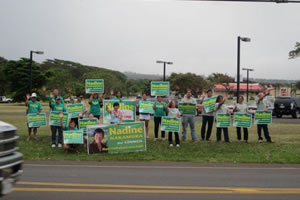 “Nadine is the kind of person everyone should have in their lives,” says Yatsko, a longtime family friend. “She is the type of parent who will always take the extra snack turn in the soccer leagues, always take the extra turn driving the kids to practice or games and pitch in to help in a recycling drive.”
“Nadine is the kind of person everyone should have in their lives,” says Yatsko, a longtime family friend. “She is the type of parent who will always take the extra snack turn in the soccer leagues, always take the extra turn driving the kids to practice or games and pitch in to help in a recycling drive.”
Working with an operating budget of more than $160 million, connecting with multiple departments and studying the county’s rich history, Nakamura rarely finds extra time outside of her new political position, but when she does, she is almost always with her family, including her 90-year-old mother-inlaw, Doris.
She is also the “chief cook” and enjoys staying at a cabin in Koke’e and hiking with her family at least once or twice a year.
When asked if she plans to run again this year, she says, “For sure. It’s just a huge honor to be able to be in this position.”

